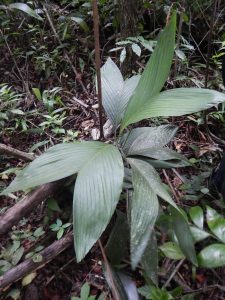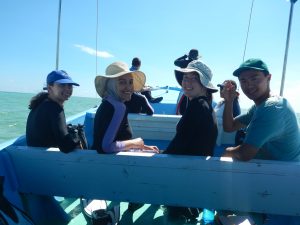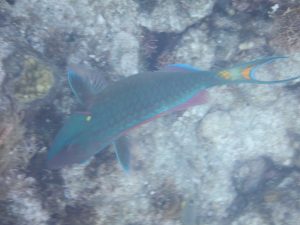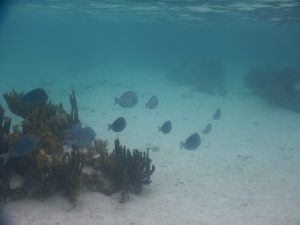Today after breakfast, Windolpho from the Belize Fisheries department came to talk to us about some of the work his department does. He told us about how Hondurans, much like the Guatemalans, come onto Belize lands (or oceans in this case) and take resources. While in in the Chiquibul, we learned that Guatemalans would come to Belize’s forests to take Xate leaves (a plant in high demand in the floral industry). Here in Glover’s Reef, Hondurans come to fish conch in mass quantities, with no respect to the fragile ecosystems that they are illegally exploiting.

We then got into our snorkel gear and went onto the boat to visit some new reef patches. The waves were pretty wild (Scott said that they were actually calm…) and lots of people felt sick. The second site was like the drop off from Finding Nemo, a coral reef that sloped off into a deep blue abyss that goes on for who knows how long. The deep clear blue was beautiful, but it was a little nerve wreaking to be floating over nothingness.

In the reef patch, I wasn’t able to dive to the benthos, which was at least 25-30 down or deeper. However, from the surface I was able to two stoplight parrotfish swimming near each other towards the base of a coral. One was using its parrot beak-like mouth to scrape algae off the coral. The other one just seemed to be hanging out. They looked about a foot long, at least from where I was looking. I also saw a blue tang at the top of a rock structure. It looked no bigger than 6 inches, but then again I was also pretty far up from it.


Lionfish is an invasive species in the Caribbean, meaning that they are native to the Indo-Pacific and were brought to this area by people who got them as pets and later released them in the wrong ocean. In Elena’s lecture later in the evening, we learned that they are responsible for eating 70% of the native fish population. We came across a few in the coral, and Scott was able to spear a huge one. The other two were too deep down and pretty hidden under some coral structures, so we couldn’t get those. We are going to dissect them in a few days, then probably eat them for lunch. Yum!
